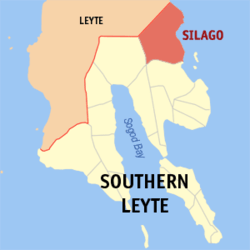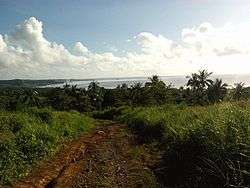Silago, Southern Leyte
| Silago | ||
|---|---|---|
| Municipality | ||
|
Landscape view of Silago and Pelada Rock (small island, middle of picture) taken from one of its farm-to-market roads | ||
| ||
| Motto: Kalimpyo, Kahimsog ug Kalinaw | ||
 Map of Southern Leyte with Silago highlighted | ||
.svg.png) Silago Location within the Philippines | ||
| Coordinates: 10°32′N 125°09′E / 10.533°N 125.150°ECoordinates: 10°32′N 125°09′E / 10.533°N 125.150°E | ||
| Country | Philippines | |
| Region | Eastern Visayas (Region VIII) | |
| Province | Southern Leyte | |
| Congr. district | Lone district of S. Leyte | |
| Established | June 20, 1950 | |
| Barangays | 15 | |
| Government[1] | ||
| • Mayor | Pacita T. Almine | |
| Area[2] | ||
| • Total | 215.05 km2 (83.03 sq mi) | |
| Population (2010)[3] | ||
| • Total | 12,310 | |
| • Density | 57/km2 (150/sq mi) | |
| Time zone | PST (UTC+8) | |
| ZIP code | 6607 | |
| Dialing code | 53 | |
Silago is a fourth class coastal municipality in the province of Southern Leyte, Philippines. It was a barrio of Hinunangan until Executive Order No. 326 dated May 17, 1951 separated it from the mother town. The town has an ebony beach with unique black sand.[4] In 2010 census, it has a population of 12,310,[3] a 10% increase from the 2007 census of 11,163 people.
History
When the Spaniards arrived, they asked the natives the name of the place. The natives, not understanding the language of the Spaniards, failed to answer the question and instead pointed to the Tuog trees where there were so many bats hanging and said “Tuay daghang Cabug”. The Spaniards looked towards the Tuog trees and, seeing many bats, called the place Murcielago, Spanish for "bat". Over time, Murcielago was shortened to Silago.
Silago was once part of the Municipality of Hinunangan, located in the northernmost part of the said town. For several years, Silago was under the political jurisdictions of Hinunangan, even during World War I and II.
During World War II, Silago was chosen as the site of submarine landing of American military arms and equipment for the Leyte guerillas. The military hardware was efficiently moved to Leyte by hundreds of volunteer guards under the Leyte area command of Col. Ruperto K. Kangleon.[5]
After the Second World War, Silago became more progressive and had increased its population, and thus became the biggest barangay of Hinunangan. Progress served as pushing factor that Silago has availed and gained qualifications to become a municipality.
In 1948, the Secretary of National Defense Ruperto Kangleon worked hard for the conversion of barrio Silago to a municipality. Finally on June 20, 1950, the new Municipality of Silago was inaugurated by virtue of an Executive Order No. 326 issued by President Elpidio Quirino. Such Executive Order was chartered through Republic Act No. 5962 “Creating the Municipality of Silago in the Province of Southern Leyte” on June 21, 1969.
This was made possible also through the invaluable services and voluntary effort extended by the late Canuto Capapas and Apolonio A. Lucero. These two Silagonhons even donated real properties as lands to meet the requirements of becoming a municipality.
The first set of Municipal Officials were appointed by President Elpidio Quirino on May 17, 1951. It was headed by Hon. Felix Balagon as Municipal Mayor, Hon. Leon Fortaliza as Vice Mayor, Hon. Manuel Tomol, Hon. Enrique Sarona, Hon. Modesto Miras and Hon. Manuel Cruzada as councilors.Mr. Pedro Tomol was appointed as Municipal Secretary.
Republic Act
REPUBLIC ACT NO. 5962 - An Act Creating the Municipality of Silago in the Province of Southern Leyte[6]
- Section 1
- The barrios of Silago, Hingatunggan, Laguma, Kikilo, Bulac, Sap-ang, Awayon, and Balagawan, and the sitios of Combis, San Roque, Talaque, Malen and Mabadyang in the Municipality of Hinunangan, Province of Southern Leyte, are separated from said municipality, and constituted into a distinct and independent municipality, to be known as the Municipality of Silago, same province. The seat of government of the new municipality shall be in the present site of the barrio of Silago.
- The boundary line of the Municipality of Silago and the Municipality of Hinunangan shall be a straight line starting from a point immediately north of the center of the barrio of Pondol passing through the summit of Mt. Nacolod to the intersection of this line with the Hinunangan-Libagon boundary line.
- Section 2
- The Municipality of Silago shall acquire corporate existence upon the election and qualification of the first mayor, vice-mayor and councilors in the next general elections for local officials. For election purposes, the municipal officials of the mother municipality charged with the election duties in accordance with the Revised Election Code shall hold office until the first officials shall have been elected and qualified.
- Section 3
- This Act shall take effect upon its approval.
Barangays
Silago is politically subdivided into 15 barangays.[2]
| Barangay | Population (2010)[3] |
|---|---|
| Balagawan | 778 |
| Catmon | 170 |
| Poblacion District I | 1,324 |
| Poblacion District II | 1,375 |
| Hingatungan | 2,108 |
| Katipunan | 549 |
| Laguma | 748 |
| Mercedes | 1,807 |
| Puntana | 283 |
| Salvacion | 623 |
| Sap-ang | 591 |
| Sudmon | 444 |
| Tuba-on | 418 |
| Tubod | 863 |
| Imelda | 229 |
Demographics
| Population census of Silago | ||
|---|---|---|
| Year | Pop. | ±% p.a. |
| 1990 | 9,733 | — |
| 1995 | 9,785 | +0.10% |
| 2000 | 10,486 | +1.49% |
| 2007 | 11,163 | +0.87% |
| 2010 | 12,310 | +3.62% |
| Source: National Statistics Office[3] | ||
Natural attractions
Silago got her name from the word “murcielago” which is a Spanish term for bat, because of this species' dominance in the locality. Proof to this is the giant bat sanctuary at Barangay Catmon. Along the coastal barangays of the town, there are clean beaches and a structure designed by nature lying in the town’s deep blue sea known as Pelada Rock, also locally known as “Batong Dako" meaning large rock, which was occupied and utilized as a camp by the Japanese Imperial Army during the Second World War. The peculiar beauty of this rock is enhanced with the abundance of birds hovering and built their nest on it, sea snakes making the rock as their dwelling place, with fish and other marine products surrounding it. The rock is located just a short distance from the shore of Barangay Laguma and Barangay Salvacion.
Farther north, is a natural rock formation with a length of more or less 50 meters from the shore and about 10 meters wide.
The interior of Silago is mountainous, in which is the town’s vast forest, home of the wild pigs locally known as “Baboy Ihas”. Among all the municipalities of the province, Silago is identified to have the biggest forest area.
The municipal tree park is another kind of tourist attraction in the municipality where fresh breeze and songs of the birds make the atmosphere pleasantly unique. On its northern part is a clean and clear river suitable for swimming.
In the upper portion of the town, at different locations, are waterfalls. Kagut-an falls is more or less 1 kilometer away from the national highway, at Barangay Katipunan. This falls is paired with another falls near its vicinity, locally called as Kagut-an Dako Dos Falls, which possesses an exceptional attraction to all who sees it. In the same barangay is another falls called Kagut-an Gamay falls. In Barangay Mercedes, about 1 kilometer distance from Mercedes Barangay Road, is Sitio Kawayan Falls with a height of about 10 meters.
Another falls is in Barangay Tubod distinctive in structure with matching cave on its opposite side. Water from this falls, along its way meets the Lanang River flow, which also has its own unique attraction.
Aside from Lanang River, which is located at the town’s mountain barangay, is the Maag River that crosses along the national highway in Poblacion District 1. This river forms a lake that is suited for boating recreation. At the mouth of the river is the brown fine sand beach of Silago, which is more or less 1 kilometer long.
In the months of November to February, Silago's beaches are ideal for surfing with huge sea waves, comparable to waves in Siargao.
Education
Elementary schools:[7]
Almost all barangays has Elementary / Primary Schools, few are mentioned below:
- Silago Central Elementary School - Brgy. Poblacion District I
- Sudmon Elementary School - Brgy. Sudmon
- Hingatungan Elementary School - Brgy. Hingatungan
- Awayon Elementary School - Brgy. Mercedes
High schools:[8]
- Silago National Vocational High School - Brgy. Poblacion District II
- Hingatungan National High School - Brgy. Hingatungan
- Mercedes National High School - Mercedes
- Katipunan National High School- Katipunan
References
- ↑ "Municipalities". Quezon City, Philippines: Department of the Interior and Local Government. Retrieved 8 July 2013.
- 1 2 "Province: Southern Leyte". PSGC Interactive. Makati City, Philippines: National Statistical Coordination Board. Retrieved 10 July 2013.
- 1 2 3 4 "Total Population by Province, City, Municipality and Barangay: as of May 1, 2010" (PDF). 2010 Census of Population and Housing. National Statistics Office. Retrieved 10 July 2013.
- ↑ ___________. "Silago". www.southernleyte.gov.ph. Retrieved 2016-04-28.
- ↑ ___________. "Silago". www.southernleyte.gov.ph. Retrieved 2016-04-28.
- ↑ Juris, The Corpus (1969-06-21). "R.A. No. 5962: An Act Creating the Municipality of Silago in the Province of Southern Leyte". The Corpus Juris. Retrieved 2016-04-23.
- ↑ http://www.philippinecompanies.com/townlist/silago/southern-leyte/schools/13/?&start=10
- ↑ http://www.philippinecompanies.com/townlist/silago/southern-leyte/schools/13/?&start=10
External links
| Wikimedia Commons has media related to Silago, Southern Leyte. |
- Philippine Standard Geographic Code
- Philippine Census Information
- Local Governance Performance Management System
- silago tourist inns
- Photo Gallery
 |
Abuyog, Leyte |  | ||
| Sogod | |
Leyte Gulf | ||
| ||||
| | ||||
| Hinunangan |

